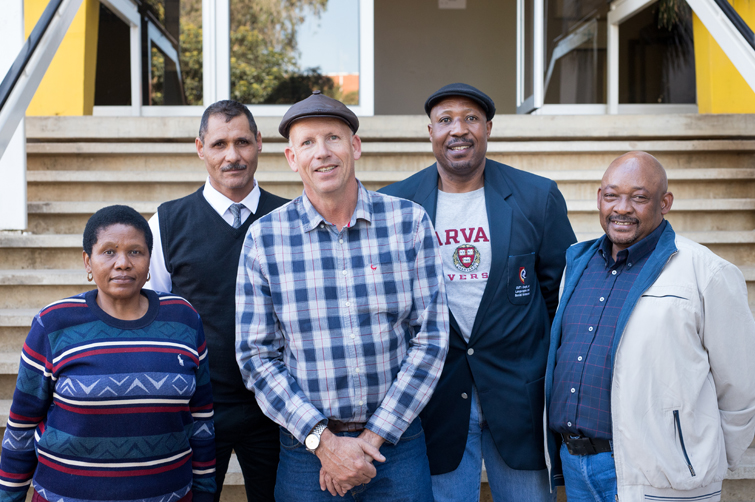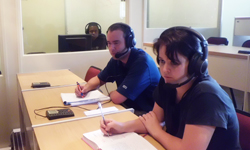Latest News Archive
Please select Category, Year, and then Month to display items
13 January 2020
|
Story Eugene Seegers
|
Photo Anja Aucamp
 Spearheading the digital expansion of the conversational Sesotho course is IDEAS Lab Director, Johann Möller (middle). With him are from the left: Prof Pule Phindane, CUT; Dr Brenton Fredericks, CUT; Bahedile Letlala, UFS Department of African Languages; and Dr Elias Malete, UFS Department of African Languages.
Spearheading the digital expansion of the conversational Sesotho course is IDEAS Lab Director, Johann Möller (middle). With him are from the left: Prof Pule Phindane, CUT; Dr Brenton Fredericks, CUT; Bahedile Letlala, UFS Department of African Languages; and Dr Elias Malete, UFS Department of African Languages.
For many years now, the UFS has been offering a one-year course in conversational Sesotho for staff members; this can then be followed up with the one-year course in advanced conversational Sesotho. The conversational Sesotho for students in the Faculty of Education was introduced in 2018 at the UFS.
The Central University of Technology (CUT) needed a conversational course for its first-year students and approached the Department of African Languages for the development of such a course. Living as we do in a multilingual country; this additional language skill opens doors and often hearts as well.
Using instructional design principles
However, the need was identified by both CUT and UFS to present this crucial information in a way that would be more appealing to digital natives as well as to those less familiar with technology. The Department of African Languages on the UFS Bloemfontein Campus, together with relevant departments from the CUT, approached the IDEAS Lab located on the UFS South Campus, since they already have a reputation for being a specialist on broadcasting and repackaging curricular content for digital presentations. The IDEAS Lab provided technical advice and built the multimedia programme, which will help the user to hear and practice phrases in Sesotho, using instructional design principles. The course will be available to both staff and students belonging to the two universities.
Room for growth
Johann Möller, Director of the IDEAS Lab, says this pilot programme will give both institutions the opportunity to test the use of multimedia for language acquisition. He adds, “Language is extremely complex, and we would like to expand this learning aid in the future.” In fact, the original design has room for growth built into it.
To keep things simple for the user and the building team, it was decided to start out with only four potential everyday scenarios where a staff member would like to speak Sesotho: Firstly, how to greet other persons from different genders; secondly, potential scenarios one might encounter in the university environment itself; thirdly, how to deal with situations at a hospital; and finally, how to use one’s language skills at a filling station.
Pronunciation is key
Each scenario contains three to four conversations that the learner can revise, along with images and audio that illustrate the situation and assist with correct pronunciation. The system does not allow the user to progress unless they have listened to the pronunciations of the sample sentences or phrases.
Further reading material and vocabulary lists are also provided, with the result that people who are using the programme can learn at their own pace. The authoring software Articulate Storyline was used to build the individual scenarios and each conversation or lesson within it. The lessons are also not dependent on an internet connection; they can be downloaded onto a flash memory drive and used offline.
“To interpret is more than the ability to have mastered two languages”
2014-03-27
|
 |
It is equally unfair to the accused as the victim when an untrained court interpreter is used in a court case.
In South Africa there are currently a large percentage of interpreters employed by the Department of Justice without any formal training.
While interpreting is in reality a very complex subject, the general acceptance is that everybody who is able speak two languages or more can be an interpreter.
This perception harms interpreting as a profession, as it results in most institutions appointing any multilingual person as an interpreter.
In many cases people are used to interpret into and from their third or fourth language (of which Afrikaans is one). This leads to inaccuracy and the incorrect use of expressions and terminology. Specific cognitive processes also have to be developed and practiced.
The University of the Free State (UFS) has since 2008 trained approximately 200 court interpreters in South Africa. This training includes the theory of interpreting and practical exercises, as well as the development of terminology and a basic knowledge of the legal system in South Africa.
The training provided to court interpreters by the Unit for Language Management and Facilitation, is done in conjunction with the Department of Justice and Constitutional Development and SASSETA (Safety and Security).
Apart from Afrikaans, native speakers of all South African languages are included in the training.
Much attention (rightfully) are given to interpreters who can interpret between the nine African languages and (mostly) English, but in the process the development of interpreters between Afrikaans and English was neglected, as became apparent in the past two weeks during the Oscar Pistorius case.